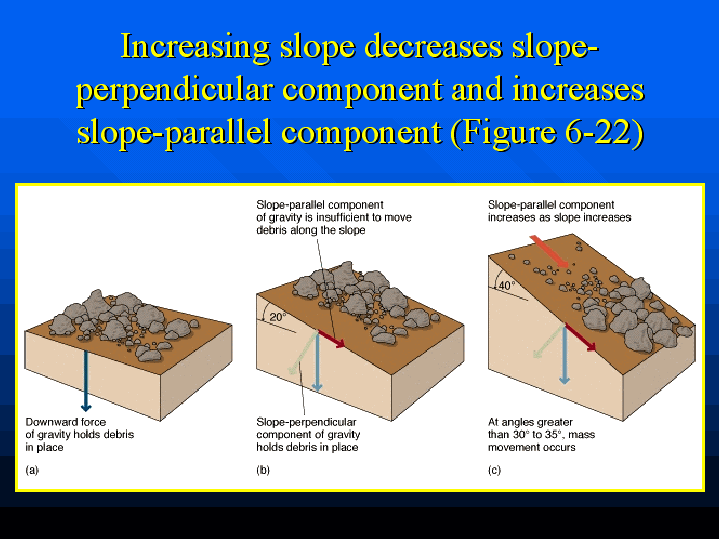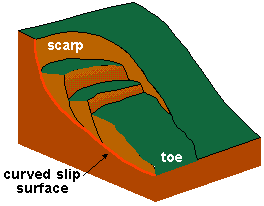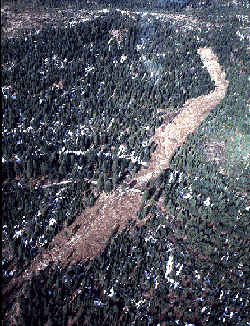
MASS MOVEMENT
Pictures from: http://www.geo.duke.edu/geo41/mmo2.htm
What causes mass
novement?
Underlaying cause: Material on the slope became loosened,
and when pulled by gravity mowe downslope.
Principal factor causing movement:
-gravity
Principal factors provide resistance:
-Friction between the slope and loose material
-Strength and cohesiveness of the loose material
Gravity, friction,
slope angle
The two main factor of the movement is
gravity
friction
Gravity has two component:
1. parallel to the slope (Gd) (works to pull material down)
2. Perpendicular (Gp) contributes to the effect of friction

Friction (F) is the force oppeses motion between two bodies
in contact
The steeper the slope the larger is Gd, and more likely the material will slide down.
Slope composition
1.Solid rocks
They tend to be completely stable even if they form vertical cliff
However they can also be site of mass movement if:
-Tectonic deformation
-mechanical weathering (frost wedging)
-sedimentary rocks with bedding planes
- the rock is soluble (caves-collapse)
-it is a metamorphic rock and foliated
When the plane of weakness is parallel to the surface of a
steep slope the rock will break along that plane.
2.Unconsolidated
material
-If it is dry- the slope is stable, if Gp>Gd.
Gd increases with the steepness of the slope.
-The max. angle of the slope where it is still remaining stable is the so called ANGLE OF REPOSE (for dry sand 30-35°)
-steepest slope in angular, poorly sorted congl. or breccia
Vegetation
The vegetation especially the deep rooted dense veg. tends to stabilize
the
unconsolidated material. (grass has very deep root system)
Water
Water, more than any other factor is likely cause the stable slope become
instable and slide. (Few water however tends to stabilize it) and it is also good
to the vegetation.
-LOTS OF WATER however is
decrease the friction between the grains (Car
tires on the road when there is a big rain).
SETTING
OFF A MASS MOVEMENT
Natural
triggers
Torrential rains (1967 Brasil 1200 died)
Earthquake (1970 Peru, 1500 milliom m3 ice, water, mud 30,000 died)
volcanic eruption (1980 Mt. St
Helens)
HUMAN
INDUCED TRIGGERS
Missmanagement of water and vegetation (French)
Oversteepeng, overloading slopes
Mining miscalculation
Overirrigated slopes in farming area
Install leaking septic systems on slopes
ex. (Family in Los Angeles left the lawn sprinkles on)
Clear cut forested slope
Cut into bases of sensitive slopes for home
blasting of mines, quarriing
TYPES OF MASS MOVEMENT
| Material | Type of Movement | ||
| Fall | Slip | Flow | |
| Rock |
Rockfall |
Rockslide |
|
| Regolith | Slump |
Mudflow, Debris Flow |
|
SLOW MASS
MOVEMENT
CREEP:
This is the slowest massmovements, measured in mm’s or cm’s/year. This occur everyvhere even on the most gentle slopes. Mostly on unconsolidated materials. It moves faster on the surface, and slowlier underneath the surface. One of the primary cause of creep is thermal expansion of the underlying material.

On the left is an example of creep(Creep, Marathon, TX (Photo from NOAA)). On the right is a displaced Curb, Photo by DH, 3/4/84).
GOOD INDICATION OF CREEP, WHEN THE TREES ARE NOT UPRIGHT NO LONGER ARE VERTICAL. OLDER GRAVE STONES ARE TILTED, TELEPHONE POLES ARE TILTED AFTER A WHILE.
SOLIFLUCTION:
Special variation of creep in
polar region. It is forming on permanently frost rocks, or unconsolidated
material, when the summer heat melts just the uppermost layers and they moving
downward a bit every year. This is a little bit slowlier, than the other one.
RAPID MASS
MOVEMENT
Rapid movements can be as rapid as km per hour, or even m’s/second. They are further classified based on the type of movement.
FALL
rocks, or sediment are dislodged and drop from steep or vertical slopes (Can be dangerous)

SLIDE
A mass, rock or sediment is dislodged and moves along a plane of weakness, such as fault, fracture and bedding plane. It can be a small displacement of some soil over rocks or could involve a whole mountain side. Could go on from days to years. The material moves along the plane of weakness, which can be identified and it is called slip plane. Nature of slip plane is depend on the local geology (clay, or shale layer, bedding plane, igneous rocks (joint produced by exfoliation)
SLIP PLANE is usually flat.
Slide which separates along a concave surface is a slump. They are distiguished by crescent-shaped scarp, that forms in the landscape where the slump has attached. The steep exposed cliff face is the scar afterward. Slumps are usually dont travel too far from the original location.


1995 La Conchita, California, landslide. Photo by R.L. Schuster
mass of rock fragments and sediment moves down slope as a highly viscous fluid.
They can be dry or wet. They are more dangerous when wet. They can contain rocks, soil, vegetation, snow and so on. Its velocity is determined by its water content.
EARTHFLOW
Relatively dry mass of clayey, silty regolith, and it moves relatively slow 2m/hour. (less dangerouos)
MUDFLOW
wet, fine grained, consistancy wet concrete to muddy water. It moves in channel like lows so they can move even on very gentle slopes such as1-2°. They develop after heavy rainfall. It is char. in arid regions.
 Dorrington
debris flow, 1997, Sierra Nevada Mountains, California. Inset shows close up of
debris flow path with road (State Route 4) for scale. Images courtesy of USGS,
original photographs by Mark Reid,
Dorrington
debris flow, 1997, Sierra Nevada Mountains, California. Inset shows close up of
debris flow path with road (State Route 4) for scale. Images courtesy of USGS,
original photographs by Mark Reid,
DEBRIS FLOW
SAME AS MUDFLOW WITH LARGER PARTICLES IN IT. DEBRIS
AVALANCHE COMMOM
IN BLUE RIDGE AFTER HEAVY RAINS. THEY
OCCUR ON STEEP SLOPES, ESP. WHEN THE VEG. COVER IS REMOVED BY FIRE.

Yungay, Peru's Main Plaza before(left) and after(right)
pictures of landslide's destruction.
PREDICTING
MASS MOVEMENT
-Open eyes
-looking for
evidences of former movement, geology of slopes, angle
water content,
-Avoiding mass
movement
-dont build on
sensitive slope
has to be maps showing hazardous areas. (Insurance probably will
not cover)
Before
purchasing a property:
1.Go in and check on
it!!!!!!!
2. If you like the
view, it is a goo news, but do not by it, before taking a closer look. look for
exposed rocks, or fresh break which would tell you about the underlying
material.
3. Than investigate
the whole neighborhood if there is any evidence of a scar, is your site in the
middle of a large potential slide mass
4. Drive around the
community, and look for tilted trees, poles, so on.
5. Check on the
houses around see if they have cracks in the foundation, on the walls?
6. You
can also contact state geological survey!!!
PREVENTING
SLOPE MOVEMENTS
MUCH CHEEPER than
the clean up afterwards!!!!!!!
NONSTRUCTURAL
APPROACHES
1. plant fast
growing trees (deep root network) Broad leaved specimens (maple, elm, oaks)
protect slope from most of the rains.
2.put chemical
solutions to increase the strength of the slope materials. Cement injection.
STRUCTURAL
APPROACHES
1. Modifying slope,
building support for it, or reducing its water content.
2. Removing part of
overlying steep slopes.
3. Cutting flat
terraces into a slope (where small slides can rest.
4. Walls
5. rocks
6. The best to
prevent sensitive slopes
from water.
-drainage ditch
-plastic cover
-layer of concrete
-tunnels bringing excess water out from the slope